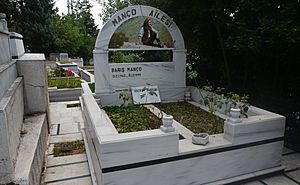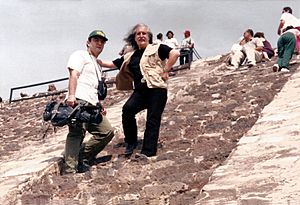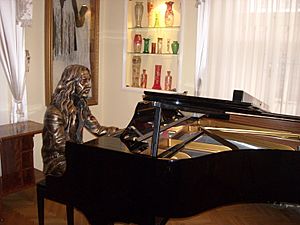Barış Manço facts for kids
Quick facts for kids
Barış Manço
|
|
|---|---|
 |
|
| Born |
Tosun Yusuf Mehmet Barış Manço
2 January 1943 |
| Died | 1 February 1999 (aged 56) Kadıköy, Istanbul, Turkey
|
| Occupation | Singer, songwriter, composer, actor, television producer and show host |
| Spouse(s) | Marie Claude (m. January – July 1970) Lale Manço (Çağlar) (m. 1978 – 1999) |
| Children | 2 |
| Musical career | |
| Genres |
|
| Instruments | Vocals, guitar, piano |
| Years active | 1958–1999 |
| Labels | Sayan Yavuz Plak CBS Disques / Grammofoonplaten SABV Türküola Emre Plak |
| Associated acts | Moğollar, Kafadarlar, Harmoniler, Les Mistigris, Kaygısızlar, Barış Manço Ve ..., Kurtalan Ekspres, George Hayes Orchestra |
| Signature | |
 |
|
Barış Manço (born Tosun Yusuf Mehmet Barış Manço; January 2, 1943 – February 1, 1999) was a famous Turkish rock musician. He was also a singer, songwriter, composer, actor, TV producer, and show host.
Barış Manço started his music journey while in high school. He helped create rock music in Turkey and was one of the founders of a style called Anatolian rock. This style mixes Turkish folk music with rock.
He wrote about 200 songs, and many of them were translated into different languages like English, French, and Japanese. He is one of Turkey's best-selling and most awarded artists. Through his TV show, 7'den 77'ye (meaning "From 7 to 77"), he traveled all over the world. Barış Manço is still one of the most loved public figures in Turkey.
Contents
Barış Manço's Early Life and Music
Barış Manço was born in Üsküdar, Istanbul, Turkey, on January 2, 1943. His mother, Rikkat Uyanık, was a well-known singer. His older brother was named Savaş ("war" in Turkish) because he was born during World War II. Barış was named "peace" in Turkish to celebrate the end of the war.
When he was in primary school, his head was shaved to prevent head lice. He later said this was one reason he decided to grow his famous long hair.
Starting His First Bands
During his high school years, Barış Manço formed his first band called Kafadarlar ("The Buddies"). This happened after he saw another band perform. In this band, a famous economist named Asaf Savaş Akat played the saxophone. The guitarist, Ender Enön, even made his own guitar because it was hard to find one back then.
In 1962 and 1963, with his next band, Harmoniler ("The Harmonies"), he recorded cover songs. He also made rock and roll versions of Turkish folk songs. This was the start of the Anatolian rock movement, which blended Turkish folk music with rock. During this time, Elvis Presley was a big influence on his music and style.
Moving to Europe and New Bands
After high school in 1963, Barış Manço moved to Europe. He traveled to Paris and Liège, where he formed bands with local musicians. He recorded some songs in English, French, and Turkish.
In 1964, he studied at the Royal Academy of Fine Arts in Liège, Belgium. He toured with his band Les Mistigris in Germany, Belgium, France, and Turkey until 1967.
In 1967, he had a serious car accident. After this, he started growing his famous mustache to hide a scar.
Forming Kaygısızlar and First Big Hit
It was hard for him to work with musicians from different countries. So, he formed Kaygısızlar (The Carefrees). This band included Mazhar Alanson and Fuat Güner, who later became members of the famous band MFÖ. He recorded several songs and toured with Kaygısızlar in Turkey and other countries.
In 1970, he formed Barış Manço Ve ... ("Barış Manço and ...") with foreign musicians. They recorded his first big hit song, Dağlar Dağlar (Mountains, Mountains!). This song sold over 700,000 copies and became very popular in Turkey and Belgium. It is still one of his most loved songs today.
Barış Manço in the 1970s
After the success of "Dağlar Dağlar," Manço recorded a few more songs with Moğollar (The Mongols), another important Turkish Anatolian rock band. He then decided to return to Turkey.
In 1972, he formed Kurtalan Ekspres. This band became legendary and stayed with him until his death. In 1975, he released his first full album, 2023. This was a concept album with many instrumental songs.
Trying for International Success
To try and become famous worldwide, he released an album called Baris Mancho in 1976. This album was mostly with the George Hayes Orchestra and was released in Europe and South Africa. Even though it didn't make him famous everywhere, it did reach the top of the music charts in Romania and Morocco. The next year, this album was released in Turkey as Nick the Chopper.
In 1975, Barış Manço also starred in a movie called Baba Bizi Eversene (Father make us marry). This was the only movie he acted in during his career. The movie's music was a collection of songs by Barış Manço and Kurtalan Ekspres.
From 1977 to 1980, he released three more albums in Turkey. These albums included some of his older songs. They were Sakla Samanı Gelir Zamanı (1977), Yeni Bir Gün (1979), and 20. Sanat Yılı Disko Manço (1980).
Barış Manço in the 1980s
In 1981, Manço released Sözüm Meclisten Dışarı with Kurtalan Ekspres. This album had many hit songs like "Alla Beni Pulla Beni," "Arkadaşım Eşek," "Gülpembe," "Halhal," and "Dönence." This album was very popular and made Barış Manço even more famous in the 1980s.
Songs for Children and Older Audiences
"Arkadaşım Eşek" ("My Friend Donkey") quickly became very popular with children. The song was about missing the countryside, but kids loved it. Throughout his career, he wrote many other songs especially for children. This made him a beloved figure among Turkish children in the 1980s and 1990s.
Another song, "Gülpembe," was written by Kurtalan Ekspres bassist Ahmet Güvenç. It was a song for Manço's grandmother. This song became very popular with older audiences and is one of his most famous songs, perhaps as popular as "Dağlar Dağlar."
In 1983, Estağfurullah, Ne Haddimize was released. It included hit songs like "Halil İbrahim Sofrası" and "Kol Düğmeleri." "Halil İbrahim Sofrası" showed Manço's unique style of writing songs with moral messages. This was rare in Turkish pop music at the time.
In 1985, 24 Ayar Manço was released. It had songs like "Gibi Gibi." This album also showed a change in Manço's music. He started using more synthesizers and drum machines. This was different from his earlier rock-based sound. In the following years, he released Değmesin Yağlı Boya (1986), Sahibinden İhtiyaçtan (1988), and Darısı Başınıza (1989). These albums also had hit songs and showed his new sound.
7'den 77'ye and the 1990s
In 1988, Barış Manço started his TV show called 7'den 77'ye (From 7 to 77). He directed and hosted this show on TRT 1, the Turkish state television channel. It was a mix of music, talk show, and documentary. The show was a huge success and ran for eight years.
Manço traveled to almost 150 countries for the show. A part of his show called "Adam Olacak Çocuk" (meaning "Child Who Will Become a Man/Woman") was made for children. This section made Manço even more popular among young people.
Even though his TV show kept him famous in the 1990s, his music albums during this time were not as successful. The albums Mega Manço (1992) and Müsadenizle Çocuklar (1995) were seen as his weaker works. However, the children's song Ayı (The Bear) from 1992 was a hit.
In 1995, he toured Japan with Kurtalan Ekspres. This led to Live In Japan (1996), which was his only live album. He released two albums in Japan and became known as "the man who writes songs about vegetables." This was because of his hit songs from the 1980s like "Domates, Biber, Patlıcan" ("Tomato, Pepper, Aubergine") and "Nane, Limon Kabuğu" (Mint, Lemon Rind).
Barış Manço's Death

On February 1, 1999, Barış Manço sadly died from a sudden heart attack. He had just finished his last work, Mançoloji (Mançology), a double album released in 1999. This album had new recordings of his hit songs and an unfinished instrumental song called "40. Yıl" ("The 40th Anniversary"). This song was meant to celebrate his 40th year in music.
His sudden death shocked almost everyone in Turkey. Millions of people were sad, and tens of thousands attended his funeral. He was buried at Kanlıca Cemetery in Istanbul.
Barış Manço's Legacy
Barış Manço was one of the most important Turkish musicians. In his early career, he and his bands helped create the Turkish rock movement. They did this by mixing traditional Turkish music with rock. This style is still very popular in Turkish music today.
His unique look, with his long hair, mustache, and big rings, helped conservative Turkish people accept rock music.
Manço was a leader in the progressive rock-influenced Anatolian rock movement in the 1970s. His experiments with electronic instruments in the late 1980s also influenced the sound of Turkish pop music in the 1990s.
His song lyrics covered many different topics. They often followed a modern version of the "aşık" (wandering folk poets) tradition. This was different from most popular music in the 1980s, which was mostly about love.
In 2002, a tribute album was released called Yüreğimdeki Barış Şarkıları ("Songs of Barış (Peace) In My Heart"). It featured 15 popular Turkish artists from different music styles like arabesque, pop, and rock. This showed how much he influenced many different musicians.
Barış Manço's Music Albums
Albums
- Dünden Bugüne (1972)
- 2023 (1975)
- Sakla Samanı Gelir Zamanı (1976)
- Baris Mancho, also known as Nick The Chopper in Turkey (1976)
- Yeni Bir Gün (1979)
- 20 Sanat Yılı Disco Manço (1980)
- Sözüm Meclisten Dışarı (1981)
- Estağfurullah ... Ne Haddimize! (1983)
- 24 Ayar Manço (1985)
- Değmesin Yağlı Boya (1986)
- 30 Sanat Yılı Fulaksesuar Manço - Sahibinden İhtiyaçtan (1988)
- Darısı Başınıza (1989)
- Mega Manço (1992)
- Müsaadenizle Çocuklar (1995)
- Barış Manço Live In Japan (1996)
- Mançoloji (1999)
- Barış Manço Golden Rollers (2018)
- Manlac Blues 9 - Demo 1965 - 1966 Volume 1 (2019)
Singles
With Harmoniler
- Twistin USA / The Jet (1962)
- Do The Twist / Let's Twist again (1962)
- Cit Cit Twist / Dream Girl (1963)
With Jacques Denjean Orchestra
- Baby Sitter / Quelle Peste / Jenny Jenny / Un Autre Amour Que Toi (1964)
With Les Mistigris
- Bizim Gibi / Big Boss Man / Seher Vakti / Good Golly Miss Molly (1967)
With Kaygısızlar
- Kol Düğmeleri / Big Boss Man / Seher Vakti / Good Golly Miss Molly (1967)
- Kızılcıklar / I'll Go Crazy (1968)
- Karanlıklar İçinde / Trip - To a Fair (1968)
- Aglama Değmez Hayat / Kirpiklerin Ok Ok Eyle (1969)
- Kağızman / Anadolu (1969)
With Barış Manço Ve
- Derule / Küçük Bir Gece Müziği (1970)
- Dağlar Dağlar 1 / Dağlar Dağlar 2 (1970)
With Moğollar
- İşte Hendek İşte Deve / Katip Arzuhalim Yaz Yare Boyle (1971)
With Moğollar / Kaygısızlar
- Bin Boğanın Kızı / Ay Osman (1971)
With Kaygısızlar / Les Mistigris
- Fil ile Kurbağa / Je te Retrouverais (1972)
With Kurtalan Ekspres
- Ölüm Allah'ın Emri / Gamzedeyim Deva Bulmam (1972)
- Lambaya Püf De / Kalk Gidelim Küheylan (1973)
- Gönül Dağı / Hey Koca Topcu Genç Osman (1973)
- Nazar Eyle Nazar Eyle / Gülme Ha Gülme (1974)
- Bir Bahar Akşamı / Estergon Kalesi (1974)
- Ben Bilirim /2023 (1975)
- Çay Elinden Öteye Rezil Dede / Vur Ha Vur (1976)
With George Hayes Orchestra / Kurtalan Ekspres
- Nick the Chopper / Lonely Man (1977)
With Kurtalan Ekspres
- Hal Hal / Eğri Eğri Doğru Doğru Eğri Büğrü Ama Yine De Doğru (1981)
Filmography
- Baba Bizi Eversene (1975)
See also
 In Spanish: Barış Manço para niños
In Spanish: Barış Manço para niños




